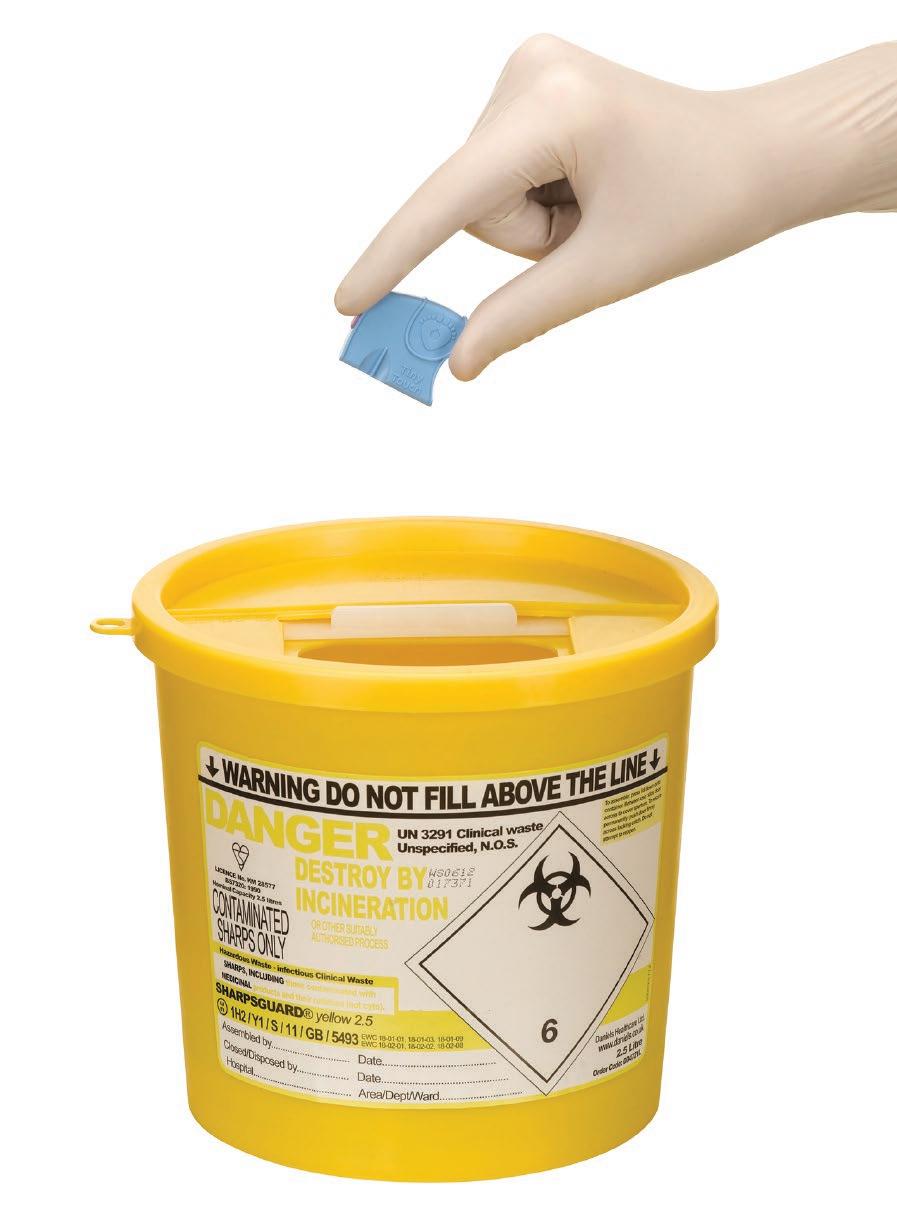
5 minute read
Prevention is Better Than Cure
from Hospital Reports – Preventing Needle Stick Injuries and the Role of Safety Devices – Owen Mumford
Camilla Slade, Staff Writer
To prevent harm, the use of sharps and needles operates in a well regulated environment
Ensuing treatment will vary from nothing at all in the event that the person who has been injured is judged at low or no risk of infection, to antibiotics, vaccination against hepatitis B and, where the risk of HIV contamination is high, treatment (such as postexposure prophylaxis (PEP)) to try and prevent infection
In the previous article, John Hancock explained what needlestick injuries are and what can happen as a result of receiving one. But most people who receive such an injury will be most interested in what to do about it.
Dealing with a Needlestick Injury
The UK Health and Safety Executive (HSE) 43 has a useful guide…
If you suffer an injury from a sharp which may be contaminated: • Encourage the wound to gently bleed, ideally holding it under running water • Wash the wound using running water and plenty of soap • Don’t scrub the wound whilst you are washing it • Don’t suck the wound • Dry the wound and cover it with a waterproof plaster or dressing • Seek urgent medical advice (for example from your Occupational Health Service) as effective prophylaxis (medicines to help fight infection) are available • Report the injury to your employer.
That would be first aid, but anyone who has received a needlestick or a sharps injury will want to get trained medical treatment as quickly as possible. The NHS 44 explains what will happen next as the injury is assessed. “The healthcare professional treating you will assess the risks to your health and ask about your injury – for example, how and when it happened, or who had used the needle. Samples of your blood may need to be tested for hepatitis B and C or HIV. Although rare, there’s also a small risk of other infections being transmitted through contaminated blood, such as cytomegalovirus (CMV) and Epstein-Barr virus. Your healthcare professional may also arrange to test samples of the other person’s blood if they give their consent.” Ensuing treatment will vary from nothing at all in the event that the person who has been injured is judged at low or no risk of infection, to antibiotics, vaccination against hepatitis B and, where the risk of HIV contamination is high, treatment (such as post-exposure prophylaxis (PEP)) to try and prevent infection, although it doesn’t always work.
A Regulated Device and Process
As in any health-related issue, prevention is better than cure and so there are regulations that govern the use and handling of sharps and needles to try to avoid injuries occurring. The regulations acknowledge that sharps such as needles and scalpels will remain essential tools for effective medical care but aim to ensure they are only used where their use cannot be avoided. Those regulations and associated resources are too many and lengthy to detail here but readers will find a useful HSE central resource with numerous links at ‘Sharps injuries – Further information’ 45 . But prevention goes further than simply only using sharps and needles where their use cannot be avoided. Often their use cannot be avoided, in which case, the UK Care Quality Commission (CQC) 46 explains that; “Health and Safety Executive guidance says an employer will need to act to manage the risks if workers: • Use sharps to provide care or other services to people; • Provide care or other services to people who are likely to use sharps; • Are involved in handling such equipment after use - for example in sterile services and waste disposal; • Are likely to inadvertently come across used sharps - for example during laundering. Employers are legally required to assess risks from sharps injuries and put appropriate control measures in place.”
Health and Safety (Sharp Instruments in Healthcare) Regulations 2013 apply to all organisations providing healthcare. This includes
nursing homes and providers delivering healthcare in residential homes or people’s own homes.
As well as risk assessments, employers are also encouraged to use safe sharps and needles. There will be more on this in following articles but the CQC guidance does also explain that; “Syringes and needles are available with a shield or cover. This slides or pivots to cover the needle after use to prevent or minimise the risk of accidental injury. ASC providers should work with prescribers and healthcare providers to make sure safer sharps are used where possible.” [author’s emphasis].
Perhaps the most significant piece of regulation in this area is the ‘European Agency for Safety and Health at Work’ Directive 2010/32/EU – prevention from sharp injuries in the hospital and healthcare sector 47 . The Directive provides a legal framework for the management of sharps and needlestick injuries (NSI) within the EU member states with the aim to; “… protect workers’ health and safety, and create a safe working environment following the hierarchy of general principles of prevention via information and consultation.” Although the UK has now left the EU, the Directive still provides an excellent structure within which to work.
Compliance with Regulations
Regulations are all well and good but, perhaps stating the obvious, they only work when people comply with them. In 2014, Building Better Healthcare 48 reported, “Worrying research has revealed that a third of NHS trusts have not properly implemented safer sharps initiatives to protect healthcare workers and patients from the dangers of needlestick injuries. Data from MindMetre reveals 33% of trusts do not instruct staff to use safety devices ‘wherever possible’ in their sharps policies, despite this being an explicit requirement of… legislation aimed at reducing needlestick incidents within the sector.” Later, in 2016, Nursing Times 49 returned to the topic to find; “NHS still failing to comply with sharps safety laws… A sample of NHS organisations has found more than 80% to be breaching sharps regulations…” One point raised was that, “The most common type of breach was a failure to use safer needles or their unsafe disposal.” We’ll address the issue of safer needles and of unsafe disposal in the following articles.
Summary
As we have already said, prevention is better than cure. Not only, and most importantly, does it avoid unnecessary discomfort and threat for patients, but also it reduces pressure on resources and consequent costs by significant margins. Because it is an area where, while the risk of injury is small, the consequences can be devastating, the use of sharps and needles is a well-regulated area. Of course, if all else fails, treatment is also important.






